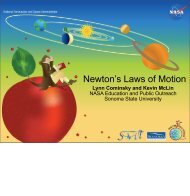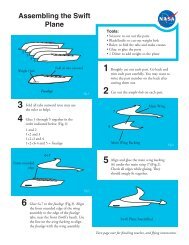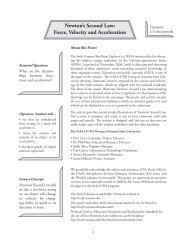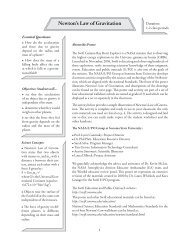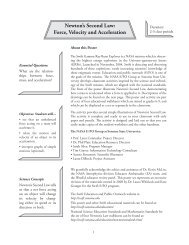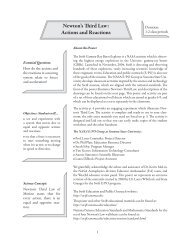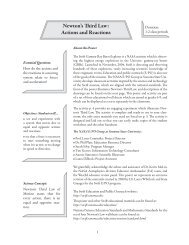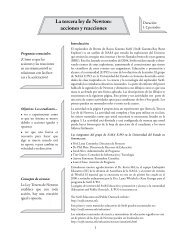Waves Light Up the Universe: Slinky booklet - Swift - Sonoma State ...
Waves Light Up the Universe: Slinky booklet - Swift - Sonoma State ...
Waves Light Up the Universe: Slinky booklet - Swift - Sonoma State ...
Create successful ePaper yourself
Turn your PDF publications into a flip-book with our unique Google optimized e-Paper software.
Contents:<br />
Introduction to <strong>Waves</strong>.................................................................................................................p 1<br />
Lesson #1: Understanding <strong>Waves</strong> ............................................................................p 5<br />
Teachers Instructions .............................................................................p 5<br />
Student Labsheet ....................................................................................p 7<br />
Lesson #2:<br />
Do <strong>the</strong> Wave! Direct and Indirect Relationships ...................................p10<br />
Teachers Instructions .............................................................................p10<br />
Student Labsheet ....................................................................................p14<br />
Student Worksheet - Frequency vs. Wavelength ...................................p16<br />
Student Worksheet - Frequency vs Energy ............................................p17<br />
National Science Standards ........................................................................................................p19<br />
National Math Standards ............................................................................................................p19<br />
Additional Resources .................................................................................................................p20<br />
Credits ........................................................................................................................................p20
<strong>Waves</strong> <strong>Light</strong> <strong>Up</strong> <strong>the</strong> <strong>Universe</strong>!<br />
This <strong>booklet</strong> contains a discussion of <strong>the</strong> basics of waves and wave motions, which is <strong>the</strong>n followed by<br />
two classroom lessons. “Classroom Activity #1: Understanding <strong>Waves</strong>” is written for <strong>the</strong> science<br />
teacher trying to introduce waves and wave motion to students. “Classroom Activity #2: Do <strong>the</strong><br />
Wave! Exploring Direct and Indirect Relationships” is for <strong>the</strong> teacher looking for a fun new way<br />
for students to investigate functional relationships.<br />
Why is <strong>the</strong> subject of waves important to understanding <strong>the</strong> <strong>Universe</strong>? All objects in our <strong>Universe</strong><br />
emit, reflect, and absorb electromagnetic waves in <strong>the</strong>ir own distinctive ways. The way an object<br />
does this provides scientists with a probe <strong>the</strong>y can use to reveal an object’s composition, temperature,<br />
density, age, motion, distance, and o<strong>the</strong>r chemical and physical quantities. While <strong>the</strong> night sky has<br />
always served as a source of wonder and mystery, it has only been in <strong>the</strong> past few decades that we have<br />
had <strong>the</strong> tools to look at <strong>the</strong> <strong>Universe</strong> over <strong>the</strong> entire electromagnetic (EM) spectrum and see it in all<br />
of its glory. Once we were able to use space-based instruments to examine infrared, ultraviolet, X-ray,<br />
and gamma-ray emissions, we found objects which were o<strong>the</strong>rwise invisible to us (e.g., black holes<br />
and neutron stars). A “view from space” is critical since radiation in <strong>the</strong>se ranges cannot penetrate <strong>the</strong><br />
Earth’s atmosphere. Many objects in <strong>the</strong> heavens “light up” with wavelengths too short or too long for<br />
<strong>the</strong> human eye to see, and most objects can only be fully understood by combining observations of<br />
behavior and appearance in different regions of <strong>the</strong> EM spectrum.<br />
We can think of electromagnetic radiation in terms of a stream of photons (massless packets of<br />
energy), each traveling in a wave-like pattern, moving at <strong>the</strong> speed of light. The only difference<br />
between radio waves, visible light, and gamma-rays is <strong>the</strong> amount of energy in <strong>the</strong> photons. Radio<br />
waves have photons with low energies, microwaves have a little more energy than radio waves,<br />
infrared has still more, <strong>the</strong>n visible, ultraviolet, X-rays, and gamma-rays.<br />
The importance of <strong>the</strong> EM radiation we receive from <strong>the</strong> <strong>Universe</strong> can be realized by considering<br />
<strong>the</strong> following: Temperatures in <strong>the</strong> <strong>Universe</strong> today range from 10 10 Kelvin to 2.7 Kelvin (in <strong>the</strong><br />
cores of stars going supernova and in intergalactic space, respectively). Densities range over 45 orders<br />
of magnitude between <strong>the</strong> centers of neutron stars to <strong>the</strong> virtual emptiness of intergalactic space.<br />
Magnetic field strengths can range from <strong>the</strong> 10 12 Gauss fields around neutron stars to <strong>the</strong> 1 Gauss<br />
fields of planets such as Earth to <strong>the</strong> 10 -9 Gauss fields of intergalactic space. It is not possible<br />
to reproduce <strong>the</strong>se enormous ranges in a laboratory on Earth and study <strong>the</strong> results of controlled<br />
experiments; we must use <strong>the</strong> <strong>Universe</strong> as our laboratory in order to see how matter and energy behave<br />
in <strong>the</strong> most extreme conditions. Understanding this behavior is central to our ability to take our current<br />
models and extrapolate <strong>the</strong>m successfully into “what will become of our <strong>Universe</strong>?” Electromagnetic<br />
radiation, across its full spectrum, provides us with almost all of <strong>the</strong> information we have about our<br />
amazing <strong>Universe</strong>, its structure, and its ultimate fate. Truly, waves light up our <strong>Universe</strong>!<br />
1
<strong>Waves</strong> <strong>Light</strong> <strong>Up</strong> <strong>the</strong> <strong>Universe</strong>!<br />
Just exactly what is a wave? How is it defined in science? And what do waves have to do with<br />
<strong>the</strong> <strong>Universe</strong>? A wave is defined as any disturbance from an equilibrium condition which travels (or<br />
propagates) with time from one point in space to ano<strong>the</strong>r. We are familiar with many different types of<br />
waves in our everyday lives -- waves in <strong>the</strong> ocean, sound waves, and light, just to name a few.<br />
Let us think about and compare waves of light to waves in <strong>the</strong> ocean. While <strong>the</strong> waves in an ocean<br />
travel forward, <strong>the</strong> water molecules <strong>the</strong>mselves are displaced only vertically. They do not travel<br />
forward with <strong>the</strong> wave. So a cork would bob up and down as <strong>the</strong> waves move along <strong>the</strong> surface of<br />
<strong>the</strong> water. (Ignore <strong>the</strong> ever-present ocean currents for this discussion.) <strong>Waves</strong> that propagate with this<br />
type of motion are called transverse waves. <strong>Light</strong> also propagates as a transverse wave. Two of <strong>the</strong><br />
unique features of light are that it does not require a medium through which to travel, and that, in fact,<br />
it travels with its highest velocity through a vacuum.<br />
Sound waves are completely different. First, sound is a physical vibration in matter. Sound cannot<br />
travel at all in a vacuum. Second, <strong>the</strong> displacements of matter that carry a sound impulse are in a<br />
longitudinal direction; that is, in <strong>the</strong> same direction as <strong>the</strong> wave motion (as opposed to perpendicular<br />
to it like for corks on oceans or light). Sound is a travelling wave consisting of alternating compressions<br />
and rarefactions (expansions) of <strong>the</strong> matter through which it moves.<br />
For any kind of wave (ocean, light, or sound), however, <strong>the</strong>re exists a simple relationship between<br />
wavelength and frequency. The wavelength is measured as <strong>the</strong> distance between two successive<br />
crests in a wave. The frequency is <strong>the</strong> number of wave crests that pass a a given point in space<br />
each second.<br />
2
Imagine a long train of waves moving toward <strong>the</strong> right, past point O in <strong>the</strong> diagram shown below.<br />
It is moving with a velocity equal to v. If v is measured in m/sec, we can measure back to a distance of<br />
D meters to <strong>the</strong> left of O and find <strong>the</strong> point P along <strong>the</strong> wave train that will just reach point O after a<br />
length of time equal to 1 second. The frequency of <strong>the</strong> wave train, that is <strong>the</strong> number of waves to pass<br />
point O during <strong>the</strong> second is just <strong>the</strong> number of waves between points O and P. That number of waves,<br />
times <strong>the</strong> length of each wave, L, is equal to <strong>the</strong> distance D. Thus we can see that for any wave motion<br />
<strong>the</strong> speed of propagation equals <strong>the</strong> frequency times <strong>the</strong> wavelength:<br />
v = f • L .<br />
When we start to think about waves of light, we need to understand <strong>the</strong> concept of a photon. A<br />
photon is <strong>the</strong> quantum of electromagnetic wave energy. It is sometimes easiest to consider a photon<br />
to be a tiny packet of pure energy; quantum <strong>the</strong>ory in physics <strong>the</strong>n tells us that each photon of light<br />
carries a discrete amount of energy that depends only on <strong>the</strong> frequency of <strong>the</strong> radiation it comprises.<br />
Specifically,<br />
E = h • f ,<br />
where f is <strong>the</strong> frequency and h is a constant value known as Planck’s constant (named after <strong>the</strong> German<br />
physicist Max Planck (1858-1947), who was one of <strong>the</strong> originators of quantum <strong>the</strong>ory). The value of<br />
Planck’s constant is 6.62x10 -34 Joule-sec.<br />
We have already shown that frequency times wavelength is equal to <strong>the</strong> speed of a wave. If we<br />
combine our two equations above and apply <strong>the</strong>m to a photon, we see that a photon’s energy is<br />
inversely proportional to its wavelength:<br />
E = h • c / L .<br />
Photons of violet and blue light are thus higher energy, higher frequency, and shorter wavelength than<br />
those of red light. The highest energy photons are gamma-rays; <strong>the</strong> lowest energy are radio waves.<br />
This range of waves from radio to gamma-ray is called <strong>the</strong> electromagnetic spectrum.<br />
3
A Note on Units<br />
• electron volt (eV) - The change of potential energy experienced by an electron moving from a place<br />
where <strong>the</strong> potential has a value of V (volts) to a place where it has a value of (V+1) (volts). This is<br />
a convenient energy unit when dealing with <strong>the</strong> motions of electrons and ions in electric fields; <strong>the</strong><br />
unit is also <strong>the</strong> one used to describe <strong>the</strong> energy of X-rays and gamma-rays. In terms of o<strong>the</strong>r units of<br />
energy, one eV is equal to 1.60 x 10 -12 ergs or 1.6 x 10 -19 Joules. A keV (kiloelectron volt) is equal to<br />
1000 electron volts. An MeV (mega-electron volt) is equal to one million (10 6 ) electron volts.<br />
• Joule/sec - A form of <strong>the</strong> metric unit for power. It is equal to 1 watt.<br />
• Hertz (Hz) - The unit of frequency, defined as a frequency of 1 cycle per second (or <strong>the</strong> number of<br />
times <strong>the</strong> tip-tops of <strong>the</strong> waves pass a fixed point in space in 1 second of time). The unit is named in<br />
honor of Heinrich Hertz (1857 - 1894), a German physics professor who did <strong>the</strong> first experiments with<br />
generating and receiving electromagnetic waves, in particular radio waves.<br />
4
Classroom Activity #1: Understanding <strong>Waves</strong><br />
Objective: To understand transverse and longitudinal waves and <strong>the</strong> characteristics of frequency,<br />
wavelength, and interference.<br />
Materials:<br />
• Double length slinky, rope, or o<strong>the</strong>r type of spring<br />
• Student Lab Sheet<br />
The double length slinky is essential to <strong>the</strong> success of <strong>the</strong> exercise; a second type of long spring (not<br />
a slinky) such as Science Kit’s Wave Demonstration Spring (#65940-00) can be linked to a “<strong>Slinky</strong><br />
Spring” Science Kit #663700-00. Long strings or ropes will also work for <strong>the</strong> part of <strong>the</strong> experiment<br />
beginning with question 6.<br />
Procedure:<br />
Be sure to read through <strong>the</strong> lab instructions and familiarize yourslef with <strong>the</strong> procedures. Encourage<br />
students to highlight specific instructions in <strong>the</strong> procedure.<br />
The experiments in this lab are best done in groups of 3 students: one serves as <strong>the</strong> “shaker”, one as<br />
<strong>the</strong> “holder” and one as <strong>the</strong> “observer/recorder”. Over <strong>the</strong> course of <strong>the</strong> experiments, students should<br />
rotate through each of <strong>the</strong> roles.<br />
Lab Part I. Longitudinal <strong>Waves</strong><br />
Discuss <strong>the</strong> information presented to students in <strong>the</strong> Introduction. Remind <strong>the</strong>m of <strong>the</strong> overall objective<br />
of <strong>the</strong> lab - it is not just to play with toys! The procedure for this part of <strong>the</strong> lab is described<br />
on <strong>the</strong> Student Lab Sheet.<br />
Answers to Questions:<br />
1. Sound waves and seismic waves travel as longitudinal pulses.<br />
2. The energy is dissipated in overcoming <strong>the</strong> friction between <strong>the</strong> floor and <strong>the</strong> spring.<br />
Lab Part II. Transverse <strong>Waves</strong><br />
The procedure for this part of <strong>the</strong> lab is described on <strong>the</strong> Student Lab Sheet. Suggest to <strong>the</strong> students is<br />
that <strong>the</strong>y make large pulses so that <strong>the</strong>y can more easily observe <strong>the</strong>m.<br />
Answers to questions:<br />
3. The size of <strong>the</strong> pulse changes by becoming smaller (flatter, less round).<br />
4. The reflected pulse returns on <strong>the</strong> opposite side of <strong>the</strong> spring because <strong>the</strong> person is holding<br />
<strong>the</strong> slinky in a fixed or rigid position so <strong>the</strong> spring has to invert to allow <strong>the</strong> pulse to reflect and<br />
continue to move.<br />
5. As <strong>the</strong> tension in <strong>the</strong> spring increases, <strong>the</strong> speed of <strong>the</strong> pulses increases. If <strong>the</strong> tension is<br />
decreased, <strong>the</strong> speed of <strong>the</strong> pulses will decrease. This is a direct relationship.<br />
6. When a pulse hits <strong>the</strong> boundary between <strong>the</strong> two types of material, part of <strong>the</strong> wave is reflected<br />
and part is transmitted. If <strong>the</strong> boundary is free to move <strong>the</strong> reflected pulse should be on <strong>the</strong> same side<br />
as <strong>the</strong> incident pulse, smaller than <strong>the</strong> incident pulse, <strong>the</strong> same shape as <strong>the</strong> incident pulse, and should<br />
travel with <strong>the</strong> same speed. The pulse which travels into <strong>the</strong> o<strong>the</strong>r medium will be on <strong>the</strong> same side of<br />
<strong>the</strong> new medium, but it will be smaller than <strong>the</strong> original pulse, and travel with a different speed.<br />
5
7. When <strong>the</strong> two pulses meet in <strong>the</strong> center, <strong>the</strong>y will add toge<strong>the</strong>r to make a pulse that is as large<br />
as <strong>the</strong> sum of <strong>the</strong> two pulses. The shape should be <strong>the</strong> same, just larger. The speed of <strong>the</strong> pulses<br />
remains <strong>the</strong> same as <strong>the</strong>y travel through each o<strong>the</strong>r. Students will often say that <strong>the</strong> pulses bounce off<br />
of each o<strong>the</strong>r or reflect. When this happens, suggest that <strong>the</strong> students make <strong>the</strong> pulses different sizes<br />
and that <strong>the</strong>y lower <strong>the</strong> tension in <strong>the</strong> spring.<br />
8. When pulses on opposite sides of <strong>the</strong> spring meet, <strong>the</strong>y cancel out if <strong>the</strong> pulses are <strong>the</strong> same<br />
size. If <strong>the</strong>y are not <strong>the</strong> same size <strong>the</strong> addition (or subtraction) of <strong>the</strong> pulses when <strong>the</strong>y meet should<br />
result in a smaller pulse being formed momentarily. The shape will flatten out if <strong>the</strong> pulses are <strong>the</strong><br />
same size, or become smaller if <strong>the</strong>y are not <strong>the</strong> same size. The speed of <strong>the</strong> two pulses should<br />
stay <strong>the</strong> same.<br />
9. There is a point where <strong>the</strong> spring does not move if <strong>the</strong> pulses start from opposite sides of<br />
<strong>the</strong> spring. This is called a node. The opposite motions of <strong>the</strong> spring cancel out so that <strong>the</strong>re is no<br />
movement.<br />
10. Pulses traveling in <strong>the</strong> same medium ei<strong>the</strong>r add toge<strong>the</strong>r or subtract from each o<strong>the</strong>r when<br />
<strong>the</strong>y meet.<br />
11. Wavelength and frequency are inversely proportional. As wavelength gets smaller, frequency<br />
gets higher. As <strong>the</strong> student moves his/her hand faster, <strong>the</strong> waves are closer toge<strong>the</strong>r. (Ei<strong>the</strong>r of <strong>the</strong>se<br />
three sentences is an acceptable answer.)<br />
References:<br />
• Harvard Project Physics<br />
• Modern Laboratory Experiments in Physics, Brinckerhoff and Taft<br />
• Investigations in Science: <strong>Light</strong> and Sound, Phil Parratore, Creative Teaching Press,1996<br />
6
Understanding <strong>Waves</strong> Student Lab Sheet<br />
Objective: To understand transverse and longitudinal waves and <strong>the</strong> characteristics of frequency,<br />
wavelength, and interference.<br />
Materials: Double length slinky, rope, or o<strong>the</strong>r type of spring<br />
Introduction:<br />
A wave is an oscillating, repetitive motion that travels through matter or space. They are all around<br />
us - water waves, sound waves, microwaves, and radio waves...just to name a few. <strong>Waves</strong> (except<br />
for light waves) need to travel through some sort of medium, such as a solid, liquid, or gas. These<br />
media transfer <strong>the</strong> wave energy. In a wave on <strong>the</strong> ocean, water is <strong>the</strong> medium. For a sound wave,<br />
air is <strong>the</strong> medium.<br />
There are two classes of waves, transverse and longitudinal. A transverse wave is one in which <strong>the</strong><br />
medium moves perpendicular to <strong>the</strong> wave direction. Transverse waves cause <strong>the</strong> medium to move up<br />
and down while <strong>the</strong> wave moves out from its source. An example is an ocean wave. A longitudinal<br />
wave, sometimes called a compressional wave, moves in <strong>the</strong> same direction as <strong>the</strong> medium. An<br />
example is a sound wave. Many waves move too fast or are too small to watch easily. But in a long<br />
“soft” spring, you can make big waves that move slowly.<br />
Procedure:<br />
The experiments described below are best done in groups of 3 students: one serves as <strong>the</strong> “shaker”,<br />
one as <strong>the</strong> “holder” and one as <strong>the</strong> “observer/recorder”. Over <strong>the</strong> course of <strong>the</strong> experiments, students<br />
should rotate through each of <strong>the</strong> roles.<br />
I. Longitudinal <strong>Waves</strong><br />
With a partner to help you, pull <strong>the</strong> spring out on a smooth floor to a length of about 6 to 10 meters.<br />
With your free hand, grasp <strong>the</strong> stretched spring about a meter from one end. Pull <strong>the</strong> meter of spring<br />
toge<strong>the</strong>r toward yourself and <strong>the</strong>n release it, being careful not to let go of <strong>the</strong> fixed end with your<br />
o<strong>the</strong>r hand! Notice <strong>the</strong> single wave, called a pulse, travel along <strong>the</strong> spring. In such a longitudinal<br />
pulse, <strong>the</strong> spring coils move back and forth along <strong>the</strong> same direction as <strong>the</strong> wave travels. The wave<br />
carries energy, but <strong>the</strong> spring remains stationary after <strong>the</strong> pulse has passed through it and reflected<br />
from <strong>the</strong> o<strong>the</strong>r end.<br />
1. What kinds of waves travel as longitudinal pulses? _______________________________________<br />
__________________________________________________________________________________<br />
2. What happens to <strong>the</strong> energy? ________________________________________________________<br />
__________________________________________________________________________________<br />
Note: You can see a longitudinal wave more easily if you tie pieces of string to several of <strong>the</strong> loops of<br />
<strong>the</strong> spring and watch <strong>the</strong>ir motion when <strong>the</strong> spring is pulsed.<br />
7
II. Transverse <strong>Waves</strong><br />
A transverse wave is easier to see. To make one, practice moving your hand very quickly back and<br />
forth at right angles to <strong>the</strong> stretched spring until you can produce a pulse that travels down only one<br />
side of <strong>the</strong> spring (that is, <strong>the</strong> bump on <strong>the</strong> spring due to <strong>the</strong> pulse is only on <strong>the</strong> right or left side of<br />
<strong>the</strong> spring). This pulse is called “transverse” because <strong>the</strong> individual coils of wire move at right angles<br />
to (transverse to) <strong>the</strong> length of <strong>the</strong> spring.<br />
Perform experiments to answer <strong>the</strong> following questions about transverse pulses.<br />
3. Does <strong>the</strong> size of <strong>the</strong> pulse change as it travels along <strong>the</strong> spring? If so, in what way?<br />
__________________________________________________________________________________<br />
__________________________________________________________________________________<br />
__________________________________________________________________________________<br />
4. Does <strong>the</strong> pulse reflected from <strong>the</strong> far end return to you on <strong>the</strong> same side of <strong>the</strong> spring as<br />
<strong>the</strong> original, or on <strong>the</strong> opposite side? Why?<br />
__________________________________________________________________________________<br />
__________________________________________________________________________________<br />
__________________________________________________________________________________<br />
5. Does a change in <strong>the</strong> tension of <strong>the</strong> spring have any effect on <strong>the</strong> speed of <strong>the</strong> pulses? When<br />
you stretch <strong>the</strong> spring far<strong>the</strong>r, you are changing <strong>the</strong> nature of <strong>the</strong> medium through which <strong>the</strong> pulses<br />
move.<br />
__________________________________________________________________________________<br />
__________________________________________________________________________________<br />
__________________________________________________________________________________<br />
Next observe what happens when waves go from one material into ano<strong>the</strong>r - an effect called refraction.<br />
Attach a length of rope or rubber tubing (or a different kind of spring) to one end of your spring and<br />
have your partner hold <strong>the</strong> end of it.<br />
6. What happens to <strong>the</strong> pulse when it reaches <strong>the</strong> boundary between <strong>the</strong> two media? Describe its<br />
size, shape, speed, and direction in BOTH media after <strong>the</strong> pulse reaches <strong>the</strong> boundary. Notice that<br />
<strong>the</strong> far end of your spring should now be free to move back and forth at <strong>the</strong> joint, which it was<br />
unable to do before because your partner was holding it. If you notice that <strong>the</strong> far end of <strong>the</strong> spring<br />
is not moving freely, be sure to make a note of it in your observations as you record <strong>the</strong> answer<br />
to this question.<br />
__________________________________________________________________________________<br />
__________________________________________________________________________________<br />
__________________________________________________________________________________<br />
__________________________________________________________________________________<br />
8
Have your partner detach <strong>the</strong> extra spring and once more grasp <strong>the</strong> far end of your original spring.<br />
Have him send a pulse on <strong>the</strong> same side at <strong>the</strong> same instant you do, so that <strong>the</strong> two pulses meet. The<br />
interaction of <strong>the</strong> two pulses is called interference.<br />
7. What happens when <strong>the</strong> two pulses reach <strong>the</strong> center of <strong>the</strong> spring? Describe <strong>the</strong> size, shape, speed<br />
and direction of each pulse during and after <strong>the</strong> interaction. It will be easier to see what happens in <strong>the</strong><br />
interaction if one pulse is larger than <strong>the</strong> o<strong>the</strong>r.<br />
__________________________________________________________________________________<br />
__________________________________________________________________________________<br />
__________________________________________________________________________________<br />
__________________________________________________________________________________<br />
8. What happens when two pulses on opposite sides of <strong>the</strong> spring meet? That is, send one down<br />
<strong>the</strong> right side and have your partner send ano<strong>the</strong>r down <strong>the</strong> left side at <strong>the</strong> same time. Describe as<br />
in question 7.<br />
__________________________________________________________________________________<br />
__________________________________________________________________________________<br />
__________________________________________________________________________________<br />
__________________________________________________________________________________<br />
9. As <strong>the</strong> two pulses pass each o<strong>the</strong>r when <strong>the</strong>y started on opposite sides of <strong>the</strong> spring, can you observe<br />
a point on <strong>the</strong> spring that does not move at all? Explain.<br />
__________________________________________________________________________________<br />
__________________________________________________________________________________<br />
__________________________________________________________________________________<br />
__________________________________________________________________________________<br />
10. From <strong>the</strong> observations you made in questions 7 - 9, make a general statement about <strong>the</strong> displacement<br />
caused by <strong>the</strong> addition of two pulses at <strong>the</strong> same point.<br />
__________________________________________________________________________________<br />
__________________________________________________________________________________<br />
__________________________________________________________________________________<br />
By vibrating your hand steadily back and forth, you can produce a train of pulses, or a periodic wave.<br />
The distance between any two neighboring crests on such a periodic wave is <strong>the</strong> wavelength. The rate<br />
at which you vibrate <strong>the</strong> spring will determine <strong>the</strong> frequency of <strong>the</strong> periodic wave. Produce various<br />
short bursts of periodic waves so that you can answer <strong>the</strong> following question.<br />
11. How does <strong>the</strong> wavelength depend on <strong>the</strong> frequency?<br />
__________________________________________________________________________________<br />
__________________________________________________________________________________<br />
__________________________________________________________________________________<br />
References:<br />
• Harvard Project Physics<br />
• Modern Laboratory Experiments in Physics, Brinckerhoff and Taft<br />
• Investigations in Science: <strong>Light</strong> and Sound, Phil Parratore, Creative Teaching Press,1996<br />
9
Classroom Activity #2: Do <strong>the</strong> Wave!<br />
Exploring Inverse and Direct Relationships<br />
“The amount of money in my bank account is inversely related to <strong>the</strong> money I spend.” Does this sound<br />
familiar? It’s just an ordinary situation involving money, but stated in <strong>the</strong> language of ma<strong>the</strong>matics.<br />
This relationship described (<strong>the</strong> more money you spend, <strong>the</strong> less you have in your account) is called<br />
an inverse relationship.<br />
“The test grade I receive is directly related to how well I understand <strong>the</strong> material.” This is a<br />
ma<strong>the</strong>matical statement of <strong>the</strong> direct relationship which exists between <strong>the</strong> variables “grade” and<br />
“understanding”.<br />
These are two simple examples of direct and inverse relationships. You can find additional examples<br />
everyday in your lives, and everywhere in <strong>the</strong> world around you.<br />
In exploring direct and indirect (or inverse) relationships, <strong>the</strong> following labs are often demonstrated<br />
or performed with students.<br />
1. Pour a half cup of sugar from varying heights. If you measure <strong>the</strong> height of <strong>the</strong> resulting<br />
pile and compare it to <strong>the</strong> height from which it is poured, what do you notice? Is this a direct or<br />
an inverse relationship?<br />
2. Paper cups and dry spaghetti can be used to explore ma<strong>the</strong>matical relationships. Using a<br />
paperclip, hang a paper cup from near <strong>the</strong> end of <strong>the</strong> spaghetti. Let <strong>the</strong> part of <strong>the</strong> pasta supporting <strong>the</strong><br />
paper cup hang over <strong>the</strong> edge of a table. Measure <strong>the</strong> length of <strong>the</strong> pasta from <strong>the</strong> edge of <strong>the</strong> table to<br />
<strong>the</strong> paper cup. Slowly drop pennies into <strong>the</strong> cup and make note of <strong>the</strong> number of pennies it takes to<br />
break <strong>the</strong> pasta. Get a new piece of pasta and shorten <strong>the</strong> length from <strong>the</strong> edge of <strong>the</strong> table to <strong>the</strong> paper<br />
cup. Once again, drop pennies into <strong>the</strong> cup and make note of <strong>the</strong> distance and <strong>the</strong> number of pennies it<br />
takes to break <strong>the</strong> pasta. Do this for several distances/trials. Graph <strong>the</strong> data from all of <strong>the</strong> trials in your<br />
class. Do you see a direct or an inverse relationship?<br />
The following lesson consists of 3 parts, and teaches inverse and direct relationships. Part I is a lab<br />
in which <strong>the</strong> ga<strong>the</strong>red data will be used in <strong>the</strong> later Parts. Part II examines <strong>the</strong> inverse relationship<br />
between frequency and wavelength for wave motion. Part III examines <strong>the</strong> direct relationship between<br />
frequency and energy for light waves.<br />
Part I<br />
In this activity, we investigate inverse relationships using a coiled spring.<br />
Teacher Notes:<br />
• Make sure each group has a student worksheet for this lab, a stop watch, tape measure, graph<br />
paper, double length coiled spring (or tape <strong>the</strong> end of two toge<strong>the</strong>r), and a roll (or several strips)<br />
of masking tape.<br />
• Steps 1-5 should be demonstrated in front of <strong>the</strong> class with a sample group of students.<br />
• There will need to be 4 people in <strong>the</strong> lab group for this experiment.<br />
• Each lab group will need an area of 1.5m by 6m to perform <strong>the</strong> experiment, which means that <strong>the</strong><br />
lab may have to be conducted in <strong>the</strong> hallway or outdoors. To save time, <strong>the</strong> teacher may measure of<br />
<strong>the</strong> distances and place <strong>the</strong> tape in <strong>the</strong> lab area (step 1) before <strong>the</strong> students perform <strong>the</strong> lab.<br />
10
• Make sure students are placing data in <strong>the</strong> table provided (shown below) beginning in step 5. Below<br />
we show data taken by <strong>the</strong> authors when <strong>the</strong>y did <strong>the</strong> lab as a guide for values you might expect.<br />
• Students begin plotting <strong>the</strong> data in step 10. We show a plot and <strong>the</strong> curve fit to <strong>the</strong> authors’<br />
sample data.<br />
Frequency (Hz) vs. Wavelength (cm)<br />
• Discuss errors in <strong>the</strong> lab with students to summarize. Ask students: “What errors can you identify in<br />
<strong>the</strong> experiment which might keep <strong>the</strong> results from being exactly what <strong>the</strong>y should be?”<br />
Tell students that first and foremost is <strong>the</strong> fact that <strong>the</strong> velocity of <strong>the</strong> waves generated in <strong>the</strong> lab<br />
are not constant as you attempt to achieve higher and higher frequencies (i.e., smaller and smaller<br />
wavelengths). Also, it is doubtful that you precisely achieve a standing wave, where every crestto-crest<br />
is an equal distance. But still...you will undoubtedly see in <strong>the</strong> data that frequency and<br />
wavelength have an inverse relationship. The precise relationship <strong>the</strong>y share, especially as it applies to<br />
light - or <strong>the</strong> electromagnetic spectrum - will be examined in Part II.<br />
• Talk about <strong>the</strong> units of frequency. To a physicist, <strong>the</strong> unit is <strong>the</strong> Hertz (Hz), which stands for 1<br />
cycle per second. This is <strong>the</strong> same as “1/sec” when doing dimensional analysis...<strong>the</strong> “cycle” does not<br />
appear as a unit. So if you have L • f, you have units of (m) x (1/sec) or m/sec. The “cycles” don’t<br />
appear. This will be important in Part II.<br />
11
Part II<br />
Although <strong>the</strong> spring lab performed in Part I may not produce an exact result, students should have seen<br />
that wavelengths and frequencies are inversely related. As a matter of fact, wavelength and frequency<br />
are defined by an inverse relationship, L = v/f. In this equation, v is <strong>the</strong> velocity at which <strong>the</strong> wave is<br />
travelling. Tell <strong>the</strong> students that in this investigation, this relationship will be examined closer.<br />
Teacher Notes:<br />
• Discuss with students that light is a form of waves - electromagnetic waves. Depending on <strong>the</strong><br />
wavelength of <strong>the</strong> wave, we refer to it as radio, microwave, infrared, visible, ultraviolet, X-ray, or<br />
gamma-ray. Post <strong>the</strong> Table below on <strong>the</strong> board or on <strong>the</strong> overhead projector for <strong>the</strong> students to examine<br />
it. It is a table of values that correspond to <strong>the</strong> electromagnetic (EM) spectrum, with a representative<br />
value of wavelength (L), frequency (f), and energy (E) given for each region of <strong>the</strong> spectrum.<br />
• The Student Worksheet for Frequency and Wavelength can <strong>the</strong>n be handed out.<br />
• Students will enter <strong>the</strong> data for Frequency and Wavelength from <strong>the</strong> Table you have shown <strong>the</strong>m into<br />
<strong>the</strong>ir data sheets. They will <strong>the</strong>n calculate velocity, v = f • L.<br />
• Students should remember in step 2 that Hz = 1/sec, <strong>the</strong>refore producing m/sec when multiplied<br />
by m (wavelength).<br />
• In step 3, students should calculate approximately 3x10 8 m/sec. This is an important velocity with<br />
great significance when discussing <strong>the</strong> EM spectrum; it is <strong>the</strong> speed (or velocity) of light. Students<br />
should recognize this in step 4.<br />
• For additional practice, suggest that students go back to <strong>the</strong> data <strong>the</strong>y took with <strong>the</strong> coiled springs.<br />
Using <strong>the</strong> wave velocity equation, how fast were <strong>the</strong> waves <strong>the</strong>y generated travelling?<br />
Part III<br />
During <strong>the</strong> lab in Part I, <strong>the</strong> students should have noticed that to create a higher frequency wave<br />
required more energy. This implies that <strong>the</strong> relationship between frequency and energy is a direct<br />
relationship. In this Part, we will examine <strong>the</strong> exact nature of this relationship as it applies to<br />
12
electromagnetic waves. Students should receive a copy of <strong>the</strong> Frequency and Energy Worksheet in<br />
order to complete this final part of <strong>the</strong> lesson.<br />
• Students will examine <strong>the</strong> graph shown below. Discuss <strong>the</strong> unit of energy, <strong>the</strong> electron-volt (eV),<br />
used in <strong>the</strong> graph. One eV is equal to 1.6 x 10 -19 Joules. The unit of eV is often used by scientists<br />
because of how small <strong>the</strong> energies of individual photons are when expressed in <strong>the</strong> unit of Joules.<br />
Frequency vs Energy<br />
• The graph shows <strong>the</strong> relationship between energy and frequency - <strong>the</strong> relationship is direct and<br />
linear. Only a small part of <strong>the</strong> frequency range of <strong>the</strong> EM spectrum is shown (a subsection of <strong>the</strong><br />
ultraviolet region). Students can use this segment to determine <strong>the</strong> equation which should apply to <strong>the</strong><br />
whole EM spectrum, and <strong>the</strong>n apply it (recall, E = h • f, where h is Planck’s constant equal to 4.13x<br />
10 -15 eV-sec). In step 5, students should see that as you increase frequency by 1 x 10 15 cycles/sec, <strong>the</strong><br />
energy increases by just over 4 eV (4.13, to be exact). It is important to get <strong>the</strong>m to appreciate <strong>the</strong> wide<br />
range of frequencies or energies that <strong>the</strong> EM spectrum covers....and what a very, very small part of it is<br />
occupied by <strong>the</strong> visible region that we see with our eyes.<br />
• Unless you go to a log-log plot, it is extremely difficult to show <strong>the</strong> whole EM spectrum on a graph.<br />
This is due entirely to <strong>the</strong> enormous ranges of values encountered. Refer back to <strong>the</strong> original Table you<br />
showed with <strong>the</strong> EM spectrum data for energy, wavelength, and frequency. Pay special attention now<br />
to <strong>the</strong> ranges of <strong>the</strong> values in each column.<br />
• If additional practice is needed in <strong>the</strong> use of scientific notation, suggest students write <strong>the</strong> ranges<br />
of <strong>the</strong> EM spectrum out in standard decimal form. You can even go through <strong>the</strong> laborious process of<br />
performing <strong>the</strong> calculations in <strong>the</strong> lab without using scientific notation. Viva scientific notation!<br />
13
Group Member Names:<br />
_________________________________<br />
_________________________________<br />
_________________________________<br />
_________________________________<br />
Date ______________<br />
Period ______________<br />
Do <strong>the</strong> Wave!<br />
Student Labsheet<br />
Materials Needed for Each Group:<br />
* stop watch, tape measure, graph paper, double length slinky (or tape <strong>the</strong> end of two toge<strong>the</strong>r), and<br />
a roll (or several strips) of masking tape.<br />
Roles:<br />
There will need to be 4 people in <strong>the</strong> lab group for this experiment.<br />
1. Length Spotter (who will “spot” <strong>the</strong> length of a wave)<br />
2. Wave Maker (who will move <strong>the</strong> slinky from one end)<br />
3. Frequency Reporter (who will hold <strong>the</strong> slinky at <strong>the</strong> o<strong>the</strong>r end and count <strong>the</strong> number of times<br />
waves pass over 10 seconds)<br />
4. Data Recorder (who will record <strong>the</strong> data for <strong>the</strong> lab team)<br />
Procedure:<br />
1. Put strips of masking tape about 50 cm apart on <strong>the</strong> floor. Continue <strong>the</strong> process until you have<br />
a length of about 6 meters marked off. This will serve as your “measuring line”. The Wave Maker and<br />
Frequency Reporter sit at <strong>the</strong> opposite ends of <strong>the</strong> measuring line (so about 6 meters apart).<br />
2. The Length Spotter should stand beside <strong>the</strong> measuring line roughly at mid-length. These tape<br />
pieces will allow <strong>the</strong> Spotter to determine <strong>the</strong> wavelength of <strong>the</strong> waves.<br />
3. The Wave Maker and <strong>the</strong> Frequency Reporter should hold <strong>the</strong> slinky at opposite ends and <strong>the</strong><br />
Wave Maker should practice making waves as <strong>the</strong> Frequency Reporter Holds his/her end still.<br />
4. The Wave Maker should move his/her arm across his/her body a constant distance for every<br />
wave made. To increase <strong>the</strong> frequency, he/she will just simply move his/her arm across that distance<br />
in a shorter period of time. Once <strong>the</strong> Wave Maker gets into a consistent motion, <strong>the</strong> Data Recorder<br />
should say “start” and <strong>the</strong> Frequency Reporter should start counting waves as <strong>the</strong>y reach his/her end.<br />
You might want to practice this once or twice.<br />
Let <strong>the</strong> Data Collecting begin! Follow <strong>the</strong> steps below and use <strong>the</strong> data table provided to record<br />
<strong>the</strong> data.<br />
5. As <strong>the</strong> Frequency Reporter is counting <strong>the</strong> waves, <strong>the</strong> Length Spotter should be examining <strong>the</strong><br />
length of <strong>the</strong> wave, using <strong>the</strong> pieces of masking tape as a guide. Estimations can be made between <strong>the</strong><br />
50 cm scale. Remember, a wavelength can be measured from “crest” to “crest”.<br />
14
6. Stop after <strong>the</strong> Recorder calls 10 seconds.<br />
7. Data Recorder should record <strong>the</strong> wavelength and frequency in <strong>the</strong> table. In <strong>the</strong> column labeled<br />
“Level of Effort (Energy) Required”, <strong>the</strong> Wave Maker should record a number from 1 to 10, which<br />
qualitatively evaluates <strong>the</strong> amount of energy used to create <strong>the</strong> wave for this trial. “1” would represent<br />
“very little energy” and “10” would represent “Uncle! Uncle! I can’t go on a second more!”<br />
8. Calculate <strong>the</strong> number of crests per second and enter <strong>the</strong> result in <strong>the</strong> appropriate column.<br />
9. Repeat steps 4-8 at least 4 more times. In <strong>the</strong> beginning, produce <strong>the</strong> longest wavelength. As<br />
<strong>the</strong> steps are repeated, for each trial consistently decrease <strong>the</strong> wavelength.<br />
10. Plot <strong>the</strong> frequency (in crests per second) versus <strong>the</strong> wavelength on your graph paper. Explain<br />
<strong>the</strong> relationship that you observe.<br />
__________________________________________________________________<br />
__________________________________________________________________<br />
__________________________________________________________________<br />
__________________________________________________________________<br />
11. Given what you know about waves, what errors can you identify in <strong>the</strong> experiment that will<br />
keep <strong>the</strong> results from being exactly what <strong>the</strong> <strong>the</strong>ory predicts?<br />
__________________________________________________________________<br />
__________________________________________________________________<br />
__________________________________________________________________<br />
__________________________________________________________________<br />
__________________________________________________________________<br />
15
Name ______________________________________ Date ______________ Period ______<br />
<strong>Waves</strong> <strong>Light</strong> <strong>Up</strong> <strong>the</strong> <strong>Universe</strong>... Frequency and Wavelength<br />
Student Worksheet<br />
1. Examine <strong>the</strong> table of data <strong>the</strong> teacher just presented to you. For each range of <strong>the</strong> EM<br />
spectrum, as noted in <strong>the</strong> Table below, record <strong>the</strong> typical wavelength and frequency.<br />
2. For each of <strong>the</strong> ranges, multiply “L” by “f” and place each value in <strong>the</strong> “Wvlgth•Freq”<br />
column. Be mindful of <strong>the</strong> units. When multiplied, <strong>the</strong> units for <strong>the</strong> result become ______________,<br />
which is a measure of velocity. Enter <strong>the</strong> units into <strong>the</strong> appropriate place in <strong>the</strong> Data Table.<br />
3. What pattern do you notice in <strong>the</strong> results of your calculations? What is <strong>the</strong> average value of<br />
velocity do you get over all of <strong>the</strong> EM spectrum ranges?<br />
___________________________________________________<br />
___________________________________________________.<br />
4. Does this value have any special significance?<br />
___________________________________________________<br />
___________________________________________________.<br />
16
Name ______________________________________ Date ______________ Period ______<br />
<strong>Waves</strong> <strong>Light</strong> <strong>Up</strong> <strong>the</strong> <strong>Universe</strong>... Frequency and Energy<br />
Student Worksheet<br />
1. Examine your Data Table from Part I. What did you notice about <strong>the</strong> level of effort required (or<br />
<strong>the</strong> energy used) by <strong>the</strong> Wave Maker as <strong>the</strong> frequency increased? Describe what insight this provides<br />
into <strong>the</strong> ma<strong>the</strong>matical relationship between energy and frequency.<br />
________________________________________________________________________<br />
________________________________________________________________________<br />
________________________________________________________________________<br />
2. Examine <strong>the</strong> graph below. What sort of relationship does it show?<br />
Frequency vs Energy<br />
3. Select five separate points on <strong>the</strong> graph and determine <strong>the</strong> frequency and energy coordinates of<br />
each. Enter <strong>the</strong>se data in <strong>the</strong> Table below. Calculate <strong>the</strong> ratio of E/f for all of <strong>the</strong> points you selected.<br />
Enter <strong>the</strong> ratios in decimal form in <strong>the</strong> Table.<br />
17
4. The ratio you found is equal to <strong>the</strong> slope of <strong>the</strong> line. Explain why this is true.<br />
_____________________________________________________________________<br />
________________________________________________________________________<br />
________________________________________________________________________<br />
This value is called Planck’s Constant. It is used in <strong>the</strong> equation that describes <strong>the</strong> relationship<br />
between energy and frequency. From what you now know, can you write this equation?<br />
_________________________________________________________<br />
5. Now, let’s think bigger. Let us examine <strong>the</strong> entire electromagnetic spectrum. In <strong>the</strong> Data Table<br />
given below, enter <strong>the</strong> value of <strong>the</strong> typical frequency of each region of <strong>the</strong> electromagnetic spectrum<br />
by using <strong>the</strong> Table of data given at <strong>the</strong> beginning of Part II.<br />
6. Given <strong>the</strong> equation you have derived for energy as a function of frequency, calculate <strong>the</strong><br />
energies which correspond to <strong>the</strong> typical frequency in each of <strong>the</strong> ranges of <strong>the</strong> electromagnetic<br />
spectrum -- from radio to gamma-ray. Enter <strong>the</strong>se values in <strong>the</strong> Data Table.<br />
7. Discuss why it would be difficult to plot <strong>the</strong> entire electromagnetic spectrum on a frequency<br />
versus energy plot of <strong>the</strong> type shown above.<br />
____________________________________________________________________<br />
_______________________________________________________________________<br />
_______________________________________________________________________<br />
18
National Science Content Standards Involved<br />
• Grades 9-12 Physical Science:<br />
* Conservation of Energy and <strong>the</strong> Increase of Disorder:<br />
“The total energy of <strong>the</strong> universe is constant. Energy can be transferred by collisions in<br />
chemical and nuclear reactions, by light waves and o<strong>the</strong>r radiations, and in many o<strong>the</strong>r<br />
ways; All energy can be considered to be ei<strong>the</strong>r kinetic energy, which is <strong>the</strong> energy of<br />
motion; potential energy, which depends on relative position; or energy contained by<br />
a field, such as electromagnetic waves.”<br />
* Interactions of Energy and Matter:<br />
“<strong>Waves</strong>, including sound and seismic waves, waves on water, and light waves, have<br />
energy and can transfer energy when <strong>the</strong>y interact with matter; Electromagnetic waves<br />
result when a charged object is accelerated or decelerated. Electromagnetic waves<br />
include radio waves (<strong>the</strong> longest wavelength), microwaves, infrared radiation (radiant<br />
heat), visible light, ultraviolet radiation, x-rays, and gamma rays. The energy of electro<br />
magnetic waves is carried in packets whose magnitude is inversely proportional to<br />
<strong>the</strong> wavelength.”<br />
National Ma<strong>the</strong>matics Content Standards Involved<br />
• Grades 9-12 Algebra:<br />
* Understand patterns, relations, and functions<br />
- Generalize patterns using explicitly defined and recursively defined functions;<br />
- Understand relations and functions and select, convert flexibly among, and use<br />
various representations for <strong>the</strong>m;<br />
- Analyze functions of one variable by investigating rates of change, intercepts, zeros, a<br />
symptotes, and local and global behavior;<br />
- Understand and compare <strong>the</strong> properties of classes of functions, including exponential,<br />
polynomial, rational, logarithmic, and periodic functions;<br />
- Interpret representations of functions of two variables.<br />
* Represent and analyze ma<strong>the</strong>matical situations and structures using algebraic symbols<br />
- Use symbolic algebra to represent and explain ma<strong>the</strong>matical relationships;<br />
- Judge <strong>the</strong> meaning, utility, and reasonableness of <strong>the</strong> results of symbol manipulations,<br />
including those carried out by technology.<br />
* Use ma<strong>the</strong>matical models to represent and understand quantitative relationships<br />
- Draw reasonable conclusions about a situation being modeled.<br />
National Ma<strong>the</strong>matics Process Standards Involved<br />
• Reasoning<br />
• Communication<br />
• Connections<br />
• Representation.<br />
19
Additional Resources<br />
• Imagine <strong>the</strong> <strong>Universe</strong>! Web site -- http://imagine.gsfc.nasa.gov/<br />
• <strong>Swift</strong> Mission Web site -- http://swift.sonoma.edu/<br />
• <strong>Waves</strong> -- a book by Gloria Skurznski. Available from <strong>the</strong> Astronomical Society of <strong>the</strong> Pacific’s<br />
catalog at https://www.mailordercentral.com/aspsky/.<br />
• <strong>Waves</strong>, Bill Nye Episode #51. You can purchase a video version of this episode. Information is<br />
available at http://nyelabs.kcts.org/teach/faq/faq06.html.<br />
• ExploreScience.com Web site --<br />
http://www.explorescience.com/activities/activity_list.cfm?categoryID=3 has a whole list of<br />
multimedia activities teaching about waves and <strong>the</strong>ir various phyysical properties.<br />
**********<br />
Credits<br />
This material was produced as part of <strong>the</strong> Education and Public Outreach program of NASA’s <strong>Swift</strong><br />
mission.<br />
The materials were developed by:<br />
Dr. Laura Whitlock, <strong>Sonoma</strong> <strong>State</strong> University & NASA’s <strong>Swift</strong> Mission<br />
Kara C. Granger, Teacher, Maria Carrillo HS, Santa Rosa, CA<br />
Jane D. Mahon, Teacher, Hoover HS, Hoover, AL.<br />
Special thank-yous go to <strong>the</strong> following for <strong>the</strong>ir useful additions, suggestions, and comments:<br />
Dr. Lynn R. Cominsky, <strong>Sonoma</strong> <strong>State</strong> University, Rohnert Park, CA<br />
Bruce H. Hemp, Teacher, Ft. Defiance HS, Ft. Defiance, VA<br />
Dr. Phil Plait, <strong>Sonoma</strong> <strong>State</strong> University, Rohnert Park, CA<br />
Joan Sanders, Education Specialist, NASA Goddard Space Flight Center, Greenbelt, MD.<br />
Artwork was created by Aurore Simonnet, <strong>Sonoma</strong> <strong>State</strong> University, Rohnert Park, CA.<br />
20
http://swift.sonoma.edu/epo/



